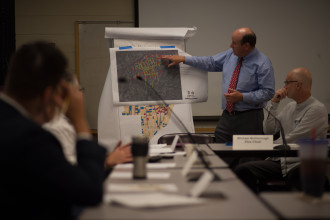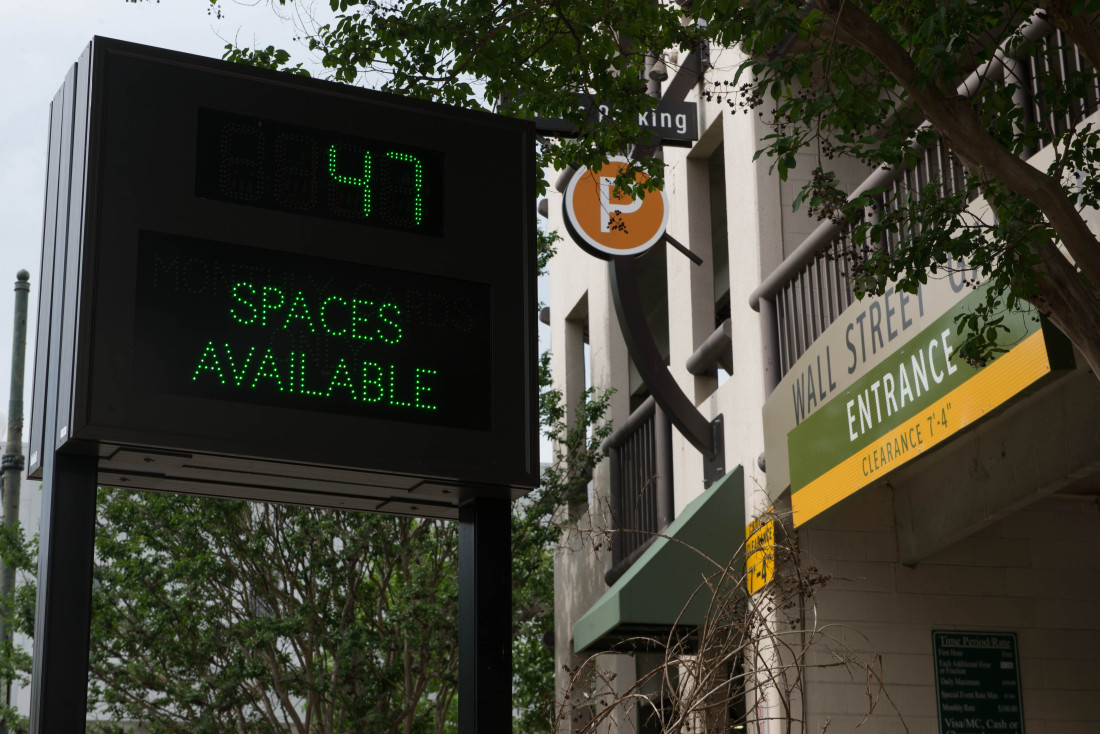Ken Putnam has a passion for parking. The city of Asheville’s transportation director says that despite complaints, he never has a problem finding a spot downtown when he drives to work. But then again, he knows where to look.
“I’m glad we’re having this discussion of running out of parking, instead of the opposite of how do we get people to come to Asheville,” Putnam told Asheville Downtown Commission members at a May 5 meeting on parking challenges in the city.
The meeting served up a preliminary look at what parking challenges this growing city will face in the next 10 to 15 years, and what resources are available to tackle those problems. Among the items discussed were things many motorists probably don’t think about: parking meter maintenance, garage life span and revenue collections.

The next few years are critical, said Putnam, due to a variety of factors. The city’s oldest and largest parking garage, at the U.S. Cellular Center, will turn 39 this year. Putnam says he uses 40 years as a benchmark for this type of structure; once they hit 40, it’s time to start thinking about either repairing or demolishing them.
“In the next two years, [the U.S. Cellular Center garage] will be undergoing heavy-duty structural maintenance, and a work engineering analysis will be performed,” he explained. Engineers will take a look at the 550-parking-space structure and decide whether to perform extensive repairs or tear it down and start anew.
“That’s the tricky part, because if we go [the latter] route, it will displace vehicles for the duration of the construction,” says Putnam explained in a later interview. “That’s a lot of cars you have to think about.”
The other garages (on Rankin and Wall streets, and Biltmore Avenue) have waiting lists for monthly parking ranging from months to years — and they’re not exactly spring chickens, either.
“In the next 10 to 15 years, all three might need to be replaced,” he noted, adding, “That’s one scenario.”
There are several garages near the Grove Arcade, yet parking continues to be an issue for both its in-town and out-of-town visitors. Ruth Summers, who handles leasing at the arcade, has worked there for 11 years.
“It can take you years to get a [rental] space, but the city doesn’t want to buy land. I think that’s being shortsighted. Every year it gets harder and harder for customers to find parking. I’d love to see the city look at it in a holistic manner — be proactive with developers, ask them if they have spaces when building, or if they are willing to put in extra parking,” she said.
Good news, bad news
Parking might be on a lot of people’s minds, but it’s just one problem the city needs to tackle.
“I think if the City Council approves buying land, it would strictly be for affordable housing at this point,” Council member Jan Davis observed during the May 5 meeting.
A hybrid system may be the answer. “The future is mixed-use parking decks,” said consultant Fred Burchett of Kimley-Horn, which has been hired by the city to present parking information culled from a comprehensive 2008 study, and subsequent 2010 and 2013 occupancy studies. “The tenants park there at night, and commuters and shoppers park during the day.”
Meanwhile, though, the booming South Slope neighborhood is experiencing growing pains due to a flurry of new businesses.
“For expansion, that’s the next logical place to go,” noted Putnam, adding, “It’s tricky, because it’s called South Slope for a reason. That presents challenges when building a garage.”
There is some good news: The current balance in the city’s parking enterprise fund is a healthy $580,000, plus an 8 percent reserve, all collected via parking fees and enforcement. Parking garages are pricey to build, though, costing an estimated $12,000 to $15,000 per space, and revelers at the new South Slope breweries shouldn’t be surprised to see parking meters pop up there in the coming years.
“We have to make sure we can cover the cost,” Putnam explained. “The enterprise fund is healthy today, but how much can it take on?”
Feeding the meters
Parking meters, though, are more complicated than one might think, and traditional ones are getting harder to find than a pay phone. But when it comes time to replace the city’s roughly 700 meters, says Putnam, “Most likely, we won’t go with a credit card machine. That’s 700 ‘points of sale’ that can go wrong,” he said.
Under the current Passport parking system, all sales go through a phone app, which counts as one point of sale. There’s also the labor cost for retrieving and handling thousands of coins, which argues against the old-school idea of asking people to fish around for quarters to feed the meter.
Another two-day parking study will be conducted this October, the city’s highest traffic month and the one Putnam said presents the worst parking conditions. Cars will be counted and parking spots noted, and the results will be compared with past data.
One thing that won’t change as long as Putnam is in charge, though, is the city’s differential parking arrangement, in which street spaces cost more than parking in a garage.
“As long as I’m here, I’d like to keep that,” he said.





Won’t the new 650 space parking deck included in the county human services building project do a lot to resolve the issue? 650 spaces is a lot of new parking…
A parking deck on the South Slope would do more than just help out the local breweries down there. McCormick Field has a terrible parking situation for the 2,400 attendees per game average. I can’t believe that no plan has been even been considered to improve parking there.
Better transit would go a long way toward defraying parking demand among people who live in Asheville’s neighborhoods but still need to drive & park to get downtown. Busses that run once per hour serve no one but those with no other choices. I’m glad we have them, but even as a transit enthusiast, I’m not going to opt to take a bus that leaves me stranded for long periods of time and drops me blocks from my destination. Can Asheville support transit investments politically? I don’t know. But it’s a better long-term solution for a vibrant downtown than more parking, more parking, and more parking.